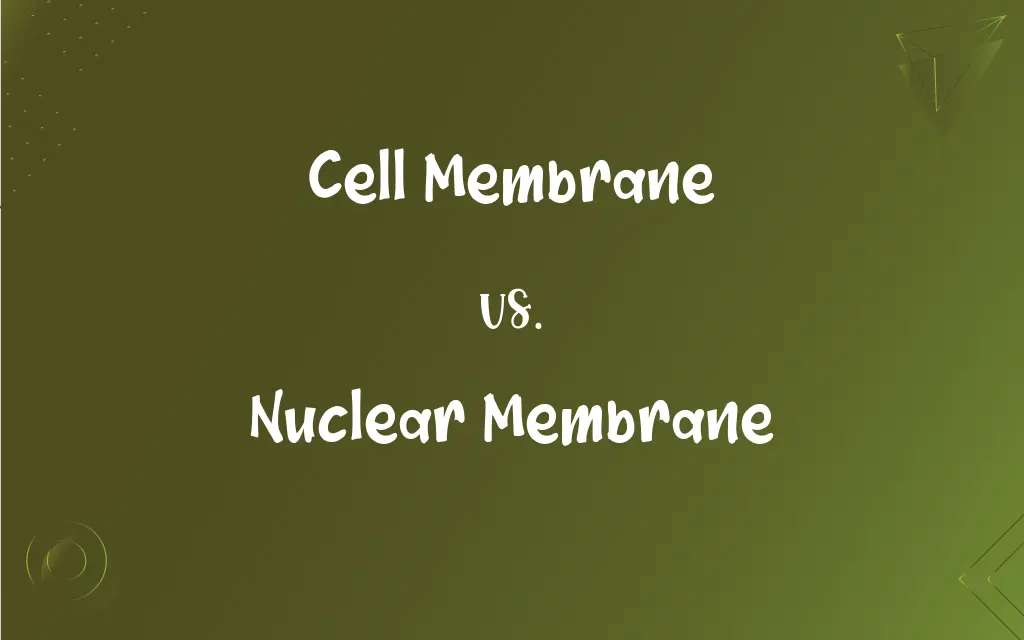Cell Membrane vs. Nuclear Membrane: What's the Difference?
By Janet White || Published on December 4, 2023
The cell membrane is the outer protective covering of a cell, controlling entry and exit of substances, while the nuclear membrane surrounds the nucleus, regulating material flow into the nucleus.

Key Differences
The cell membrane is a semi-permeable barrier enclosing the cell's contents, playing a key role in communication and nutrient transport. The nuclear membrane, also known as the nuclear envelope, specifically encloses the cell's nucleus, separating chromosomal DNA from the cytoplasm.
Composed of a lipid bilayer with embedded proteins, the cell membrane facilitates selective permeability. In contrast, the nuclear membrane consists of two lipid bilayers, with nuclear pores allowing selective passage of molecules.
The cell membrane interacts with the external environment, aiding in cell signaling and adhesion. The nuclear membrane's primary function is to protect genetic material and regulate DNA and RNA transport.
In addition to protection, the cell membrane maintains the cell's homeostasis. The nuclear membrane, while also protective, plays a crucial role in organizing chromatin and coordinating cell division.
The cell membrane's structure is dynamic, adapting to environmental changes. The nuclear membrane disassembles during cell division and reassembles afterward, a unique feature compared to the cell membrane.
ADVERTISEMENT
Comparison Chart
Structure
Single lipid bilayer with embedded proteins
Double lipid bilayer with nuclear pores
Primary Function
Regulates cell's interaction with its environment
Encloses and protects the nucleus
Permeability
Selectively permeable for substances
Contains nuclear pores for molecule transport
Interaction
External, with cell's environment
Internal, with chromatin and genetic material
Behavior During Cell Division
Remains intact
Disassembles and reassembles
ADVERTISEMENT
Cell Membrane and Nuclear Membrane Definitions
Cell Membrane
A protective barrier surrounding a cell.
The cell membrane's integrity is crucial for cell survival.
Nuclear Membrane
Disassembles during mitosis and reassembles afterward.
The nuclear membrane's disassembly allows chromosome segregation.
Cell Membrane
Composed of a lipid bilayer with embedded proteins.
The cell membrane's fluidity allows for dynamic cellular processes.
Nuclear Membrane
Protects the cell's genetic material.
The nuclear membrane safeguards DNA from cytoplasmic activities.
Cell Membrane
Involved in cell signaling and cell-to-cell communication.
Receptors on the cell membrane help in receiving hormonal signals.
Nuclear Membrane
Encloses the cell's nucleus, separating it from the cytoplasm.
The nuclear membrane maintains the nucleus's distinct environment.
Cell Membrane
Regulates the movement of substances in and out of the cell.
Oxygen passes through the cell membrane via diffusion.
Nuclear Membrane
Coordinates the flow of molecules between the nucleus and cytoplasm.
Messenger RNA exits the nucleus through the nuclear membrane.
Cell Membrane
Maintains the cell's homeostatic balance.
The cell membrane ensures the cell maintains a stable internal environment.
Nuclear Membrane
Comprises two lipid bilayers with nuclear pores.
Nuclear pores in the nuclear membrane regulate RNA and protein transport.
FAQs
Does the cell membrane participate in cell communication?
Yes, it plays a crucial role in cell signaling and communication.
What is the nuclear membrane?
The nuclear membrane encloses the nucleus, regulating material flow into it.
What are nuclear pores?
Nuclear pores are openings in the nuclear membrane for molecule transport.
How is the cell membrane structured?
It's composed of a lipid bilayer with embedded proteins.
Can the cell membrane repair itself?
Yes, the cell membrane can self-repair to some extent.
What is the role of nuclear pores?
They allow selective exchange of materials between the nucleus and cytoplasm.
Are cell membranes found in all cells?
Yes, all cells have cell membranes.
How does the nuclear membrane protect DNA?
It separates DNA from the rest of the cell, controlling access.
What is the cell membrane?
The cell membrane is the outer covering of a cell, controlling substance exchange.
Is the cell membrane selective?
Yes, it selectively allows substances to enter or leave the cell.
Does the nuclear membrane have a single or double layer?
The nuclear membrane has a double lipid bilayer.
Do cell membranes vary between cell types?
Yes, composition and structure can vary based on the cell's function.
What happens to the nuclear membrane during cell division?
It disassembles and then reassembles post-division.
What is the importance of cell membrane fluidity?
Fluidity allows the cell membrane to adapt and function effectively.
How does the nuclear membrane maintain nuclear shape?
It is supported by the nuclear lamina, providing structural stability.
What is the relationship between the nuclear membrane and chromatin?
The nuclear membrane interfaces with chromatin, influencing its organization.
Can the nuclear membrane regulate gene expression?
Yes, by controlling the transport of molecules that affect gene expression.
Can the nuclear membrane be penetrated by viruses?
Some viruses have mechanisms to cross the nuclear membrane.
How does the cell membrane affect homeostasis?
It regulates the internal environment of the cell.
What substances pass through the cell membrane easily?
Small, non-polar molecules like oxygen and carbon dioxide pass easily.
About Author
Written by
Janet WhiteJanet White has been an esteemed writer and blogger for Difference Wiki. Holding a Master's degree in Science and Medical Journalism from the prestigious Boston University, she has consistently demonstrated her expertise and passion for her field. When she's not immersed in her work, Janet relishes her time exercising, delving into a good book, and cherishing moments with friends and family.































































